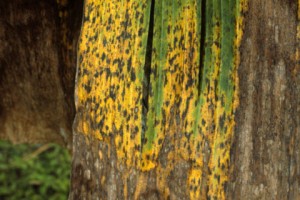Recently, our friend Eve mentioned in an offhand way that the banana as we know it is dying out. In addition to a wave of banana grief that washed over me, I also felt a small measure of relief; this was one of those news stories that I had heard a few years ago but from which I retained almost none of the scientific detail, and I had begun to think that I dreamed it. But no! The banana horror story is real, and I have collected some of its finer points here.
The tragic end of the banana was built into its genes from almost the very beginning, or at least its lucrative economic beginning. In a quest to get more uniform, shippable and still edible fruit, the banana plant was made into a seedless version of its formerly wild self. That means that they are sterile and have to be grafted onto stems by human hands in order to survive. And the variety of bananas was drastically reduced as tropical nations made room for whole plantations of the anointed breed favored by the banana companies, called the Gros Michel.
But raising an army of sterile mutants has its drawbacks. For instance, they can’t naturally evolve to ward off disease, which is exactly what happened to the Gros Michel in the 1960s when it was wiped out by a fungus called Panama disease. This, of course, sent banana scions scurrying for a replacement, and they found a lesser but viable alternative in the Cavendish banana, the variety that currently graces your supermarket shelves. But—egad!—banana lightning does strike twice, and now the Cavendish is being ravaged by a fungus called Black Sigatoka (I am not making these names up, I swear). No adequate fungicide has been found. The prognosis for the Cavendish is bleak.
So are the prospects of finding a replacement. At least, that is, a replacement that meets the rigid standards of Western distributors. The one problem that I found with the impassioned articles on banana death* was their assertion that the varieties of bananas that are left are fibrous, mealy and undesirable. I know from my time in Cambodia that this is patently untrue. I loved the bananas I ate there; they were tiny, only a few inches long, and thin-skinned, but their flesh was softer and more velvety and sweeter and…well, more banana-y. They are delicate, though, and could never be shipped to the U.S. on a grand scale, as the Cavendish is, which is why, I presume, they don’t even score a mention in the banana doomsday scenario.
And so perhaps the story becomes one more convincing point for the “eat locally” crowd. Don’t get me wrong—I enjoy a banana as much as the next person, and I haven’t stopped eating them. But it does make me wonder…why are we demanding that enormous quantities of non-native fruit be shipped hundreds of miles just so we can have the breakfast we have become accustomed to? Perhaps we should make do with apples and save our banana thirst for tropical holidays? I’m not sure. But I will consider it during the moment of silence I’m observing for the Chiquitas I have known and loved.
*Thanks to the articles “Bananas Are a Dying Breed” by Ralph Alison from CorpWatch and “Why bananas are a parable for our times” by Johann Hari from The Independent for the details on banana death.


Pingback: One Order of Rollmops, Comin’ Up | PitchKnives and Butter Forks